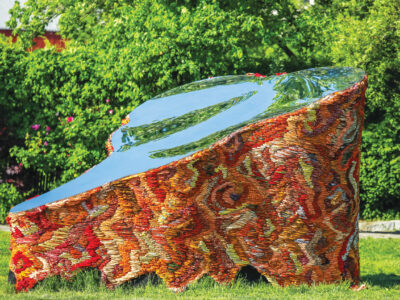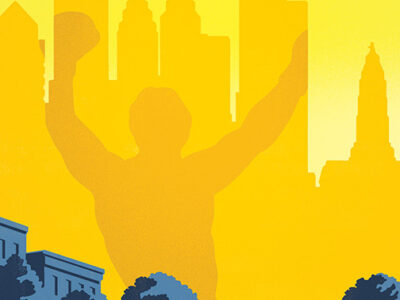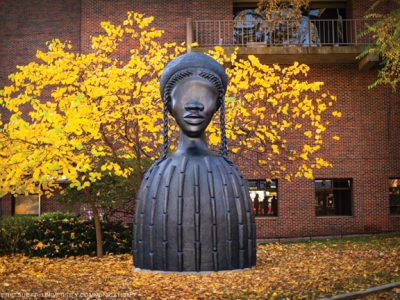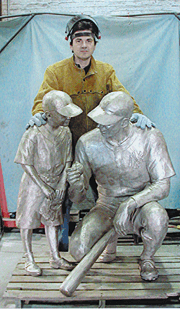
Sculptor Zenos Frudakis FA’82 GFA’83 has created monumental artwork that is displayed in every part of the globe, finding patrons among a Japanese open-air museum, the Nobel Foundation in Stockholm, and the U.S. embassy in South Africa. So the request that he got last spring from Penn’s College Houses office was a bit, well, unusual.
Frudakis was asked to create a gargoyle-like carving, or bossof Dr. David Brownlee, Harnwell College House faculty master and professor of art history who helped revamp Penn’s on-campus residential program. Presented to Brownlee at a reception recognizing his achievements as the first director of College Houses and Academic Services, the granite-colored boss displays Brownlee’s head and shoulders in front of the University shield, with his left hand firmly grasping a ship’s wheel—a reference to Brownlee’s love of sailing.
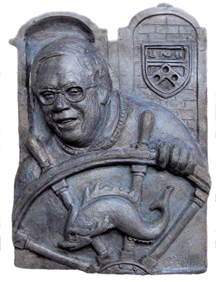
“I’m secretly glad that I don’t possess all the vigor and determination that the sculptor has depicted,” joked Brownlee after receiving the gift, “but I’m delighted to be remembered that way.”
Speaking of vigor, Frudakis worked on more than 18 life-size sculptures this fall, including one of the muscle-bound Ms. Olympia 2000, golfer Payne Stuart, an Air Force Memorial commissioned for Arlington National Cemetery, and a series of 10-feet-high bronze sculptures to commemorate legendary Philadelphia Phillies baseball players, including Mike Schmidt, in the new Phillies ballpark that will open in 2004. These monuments, like his locally famous sculpture of former Philadelphia mayor Frank Rizzo, “are not about trying to mimic reality totally,” he explains, but are also about the emotions one embodies and the mutability of life.
His work has taken him far beyond Center City Philadelphia. During apartheid, the U.S. government asked Frudakis to smuggle a bust of Dr. Martin Luther King Jr.—a prohibited symbol of peace and equality—into South Africa in a diplomatic pouch, assuring him that “we’ll try to get you out of jail” should anything go wrong.
Frudakis feels the greatest attachment, however, to his Freedom sculpture outside GlaxoSmithKline headquarters in Philadelphia. Twenty feet long, 10 feet high, and weighing 7,000 pounds, the piece depicts a human figure in four stages of breaking free from a wall. In designing the piece, “I was conscious that this is a universal desire—the need to be free from some situation, be it an internal struggle or an adversarial circumstance,” Frudakis explains.
Freedom was created with an oil-based clay, much of which was over 100 years old; in molding the piece together, Frudakis used tools that belonged to earlier sculptors, and then finished the surface with his own fingerprints. On closer examination, one can see faces emerge from the wall between the figures, many of which are fragments of people from Frudakis’s own life. “Reality is animated by one’s experience of it,” he says, adding, “none of the figures are finished because we’re all in process.”
—Sarah Blackman C’03


